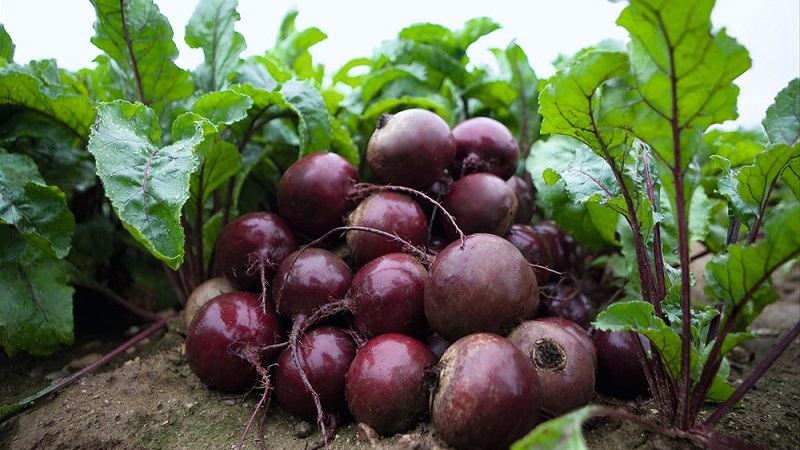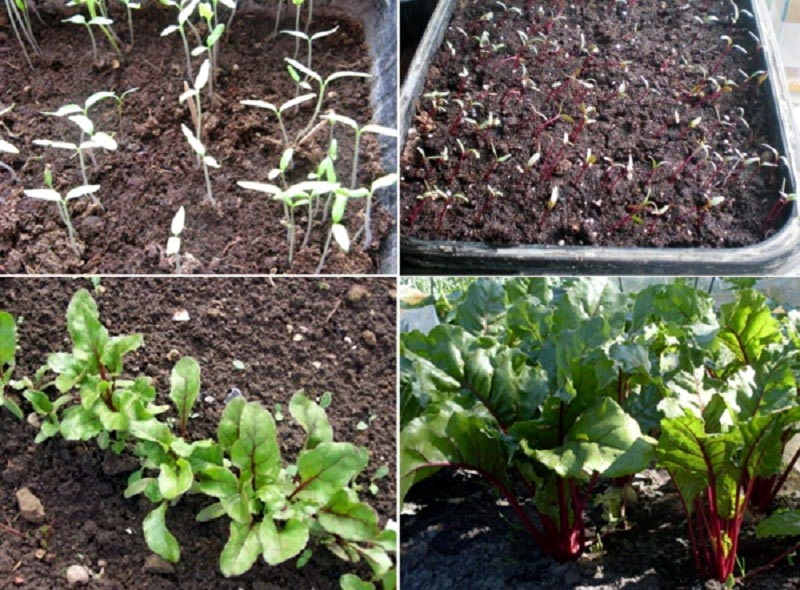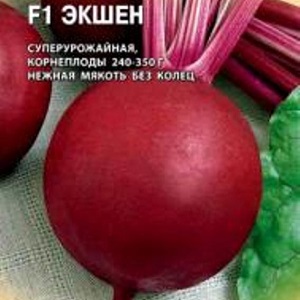Dutch hybrid beet "Action f1": features of the crop and the secrets of proper care of it
Action F1 is a mid-season beet hybrid. It has many positive qualities, which is why it is so fond of Russian gardeners. To grow a rich and high-quality crop, it is enough to follow the rules of crop rotation and crop care. Read about how to do it correctly in our article.
The content of the article
Description of the variety
Action F1 is a hybrid form of beetroot with a strong root system and leaf rosette. It belongs to the mid-season, since 100-105 days pass from the moment the first shoots appear to harvest.

The plant has a large and strong rosette of erect, smooth leaves... Their plates are pale green, and the petioles and veins are purple. With age, the foliage acquires a darker color.
The culture is resistant to color, tolerates frost and dry periods well, therefore it is suitable for growing in all regions of Russia.
Origin and development
Historical reference. The ancient Greeks were still engaged in the cultivation of beets, who greatly appreciated the culture, and its fruits were available only to the richest and most influential people. The first copies were brought to Kievan Rus from Byzantium back in the 10th century. In epics, it is often mentioned that beets allegedly increased the strength of the heroes, helping them fight monsters and enemies.
Action F1 hybrid was bred by Dutch breeders at the end of the 20th century.
Distinctive features
Action F1 differs from other varieties of beets:
- stable and rich harvest;
- resistance to flowering;
- frost and drought tolerance;
- even root vegetables without rings on the pulp;
- suitability for beam products.
Fruit characteristics, yield
The roots of the hybrid are only half submerged in the ground, they have a rounded shape without obvious irregularities and a juicy flesh of a rich red color without rings. Beets are distinguished by their pronounced taste, so they are actively used in cooking and are grown for long-term storage for the winter.
From 1 m2 can be harvested up to 10 kg... The average weight of fruits is 150-200 g, but there are specimens weighing up to 350 g.
How to grow
Action F1 is considered an unpretentious and sustainable hybrid... But in order to obtain a bountiful harvest, it is important to plant correctly, and then provide the crop with the necessary care.
Planting with seeds / seedlings
For planting beets, choose a bright spot with loose and light soilrich in organic matter. It is better to refuse clay soils or dilute them with river sand, since heavy soil reduces the quality and quantity of root crops, and also gives them an ugly shape.
Sowing in open ground is performed in the second half of May, and for seedlings at the beginning of the last month of spring.
The landing pattern is presented in the table:
| Seeding rate | 1 g / m2 (70-80 pieces) | |
| Depth of seeding in soil | sandy and sandy loam soils | 3-4 cm |
| loamy | 2-3 cm | |
| Distance between | in rows | 30 cm |
| sprouts in a row | 10-15 cm | |
Instruction for sowing in open ground:
- Dig the soil to a depth of 10-15 cm, break up all earthy clumps and remove weeds.
- Fertilize the garden with compost or humus - 2.5 kg / m2.... Also add 20 g of ammonium nitrate, 35-40 g of superphosphate and 15 g of potassium chloride (the proportions are indicated per 1 m2).
- Form grooves 2-4 cm deep, shed and sow.
- Cover the seeds with a loose and light nutritious substrate, water the garden well.

Some gardeners, especially from the northern regions of the country, prefer to plant beets in seedlings... This allows you to get a larger harvest 18-22 days earlier than when planting directly in open ground.
About other varieties of beets:
Seedling technology:
- Prepare the soil mixture. Combine peat, humus, rotted compost, turf or garden soil and river sand in a 4: 2: 2: 1 ratio. For every 5 kg of mixture, add ½ cup of wood ash. Sift the substrate and bake it in a heavy-bottomed pan, or soak it in a double boiler for an hour.
- Dip the seeds in the growth stimulant solution for one minute. Kornevin has proven itself well.
- Fill the containers with soil and sow, deepening the planting material by 2 cm.
- Moisten the planting with a spray bottle to avoid diluting the seeds.
- Cover the drawer with plastic wrap and store in a warm place. After the first shoots appear, remove the makeshift greenhouse.
After the formation of two real sheets do thinning: remove all weak shoots so that there is a distance of 5 cm between the plants. Further care of the seedlings consists in regular and moderate watering - it is enough to prevent the soil from drying out too much.
Transplant into open ground is performed then, when the sprouts get stronger and acquire several leaves. This usually happens in late May and early June.
Attention! Before sowing, it is useful to sort the seeds by size and plant the same in the same row. This will allow you to get uniform seedlings.

Care
Beetroot Care Action F1 includes the following procedures:
- Watering - once a week with warm water. In dry and hot periods, the number of waterings is increased to 2-4 times a week.
- Thinning - the first time is performed after the appearance of 2-3 true leaves, the second - after the formation of 7-8 leaves. Do not forget that a distance of 10-15 cm should be left between the shoots.
- Loosening and weeding is performed as needed to remove earth crust and weeds that prevent air and moisture from penetrating to the roots of plants.
- To feed the beets, potassium chloride is added to the soil every two weeks: 70 g of the product is diluted in a bucket of water and used for irrigation. 300 ml of solution is poured under each plant. To avoid the formation of voids in the fruits, once planting is fertilized with boron dressing.
- Mulching the beds is done with dry compost and humus. They will not allow moisture to evaporate and prevent waterlogging of the beds.
Attention! Beets tend to accumulate nitrates, so they cannot be fertilized with nitrogen fertilizers.
Features of cultivation and possible difficulties
 When growing beets, it is important to follow all care recommendations. Experienced gardeners have no difficulty in planting beets, but beginners may face such problems:
When growing beets, it is important to follow all care recommendations. Experienced gardeners have no difficulty in planting beets, but beginners may face such problems:
- The fruits crack and grow slowly. Uneven watering leads to this. To fix the problem, it is necessary to normalize the mode of moistening the beds.
- Beets are small and irregular in shape. Sowing was carried out in too dense and heavy soil.
- High humidity, frequent rains and waterlogging of the soil can lead to the appearance of a disease such as dry rot. To eliminate it, you need to add a solution of borax to the garden bed (10 g of the substance is diluted in 10 liters of water).
Reference. Salt will increase the sugar content of the crop and improve its taste. For this, a glass of salt is dissolved in a bucket of water. The solution is poured over plantings under the root.
Diseases and pests
Action F1 is a hybrid form capable of independently resisting diseases and pests... But with improper care, the gardener may face similar problems.The means that are suitable for the prevention and control of these troubles can be seen in the following table.
| Problem | Names | Remedies |
| Diseases |
|
1) Pour 1 kg of ash with 10 liters of water, cover and keep in a sunny place for a week. Top up the product with 15-30 ml of liquid soap or dish gel and spray the beetroot bed.
2) Grind a bar of laundry soap into shavings and dilute with 40 g of copper sulfate in 7 liters of water. Use for spraying once every 1-1.5 weeks. 3) Dissolve 5 ml of "Fufanon" in 5 liters of water. Perform two treatments with an interval of 7-10 days. |
| Pests |
|
1) Add 500 g of lime to 10 liters of water and stir. Pour over the tops of each sprout (the norm is 1 liter per plant).
2) Pour a bag of whey into a bucket of water. Coat the beet tops evenly. The treatment can be repeated every 3-5 days until the disease recedes. 3) Dilute 10 grams of Ridomil Gold in 5 liters of water and spray the plantings on a dry, sunny day. |
Harvesting and application of the crop
 Beets ripen at the end of September, in the southern regions it is left in the ground until the first frost. But if the tops have started to turn yellow and dry, then it's time to harvest.
Beets ripen at the end of September, in the southern regions it is left in the ground until the first frost. But if the tops have started to turn yellow and dry, then it's time to harvest.
Root vegetables are carefully dug with a shovel, trying not to damage the skin... After that, the tops are cut 1-2 cm from the beets and the crop is laid out in the shade to dry. Then the earth is removed from the fruits and placed in a cellar for storage.
Action F1 is used for the following purposes:
- pickle;
- added to soups;
- cooked for salads.
Read also:
Advantages and disadvantages
F1 action has many virtues, which is why Russian gardeners love him so much:
- adjusts to the conditions of detention;
- fruits of excellent quality;
- stored for a long time;
- able to endure cold snaps;
- short growing season;
- tolerates dry periods well (with normal watering);
- congenital resistance to many diseases and pests;
- not prone to color.
But like all garden plants, this type of beet has disadvantages:
- is not able to grow and develop properly in too dense and heavy soils;
- with a lack of water, it gives a meager harvest;
- regular waterlogging of the land is detrimental to culture.
Farmers reviews
 On internet forums mostly positive reviews of the hybrid... Here are some of them for you.
On internet forums mostly positive reviews of the hybrid... Here are some of them for you.
Maria, Lipetsk: “I chose this hybrid because it has a small cut of foliage. I can't say anything bad, but I think that elongated root crops are still better. Plus Action F1 has tough leaves, and I like to add beet tops to summer cabbage soup ".
Igor, Yekaterinburg: “An excellent vegetable without veins and rings, which, by the way, significantly spoil the taste of the pulp. Action F1 has the most expensive beet seeds I've tried. Someone may not like this, but I want to note that their germination rate can be estimated at 90%, and if you use a growth stimulator to soak the seed, then at 100% ".
Conclusion
Knowledge of the rules of growing and crop rotation of the crop will allow you to get a rich and tasty harvest of beets. Action F1 is resistant to adverse conditions, as well as to pests and diseases, so even novice gardeners can cope with the cultivation of a hybrid.